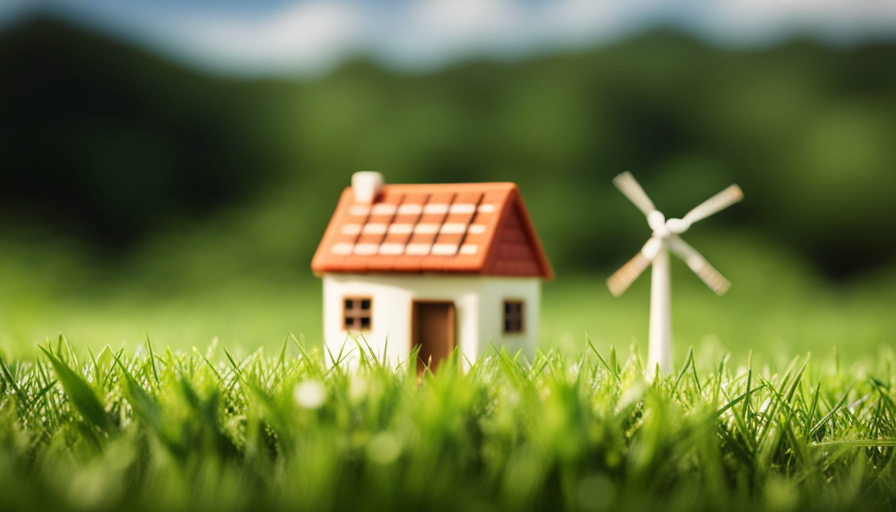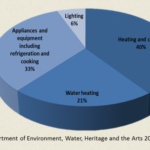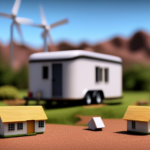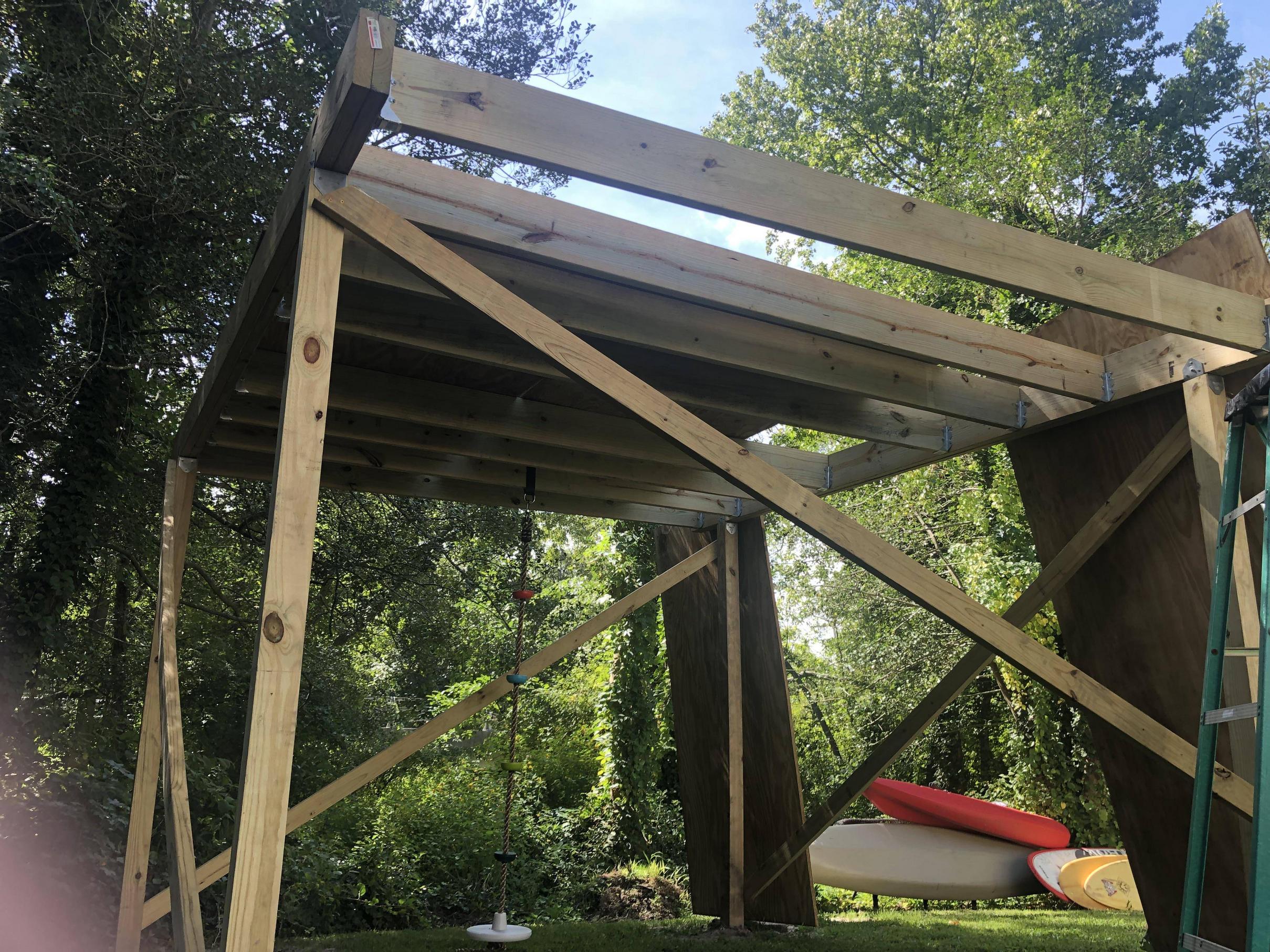How much energy does a tiny house consume in kilowatt-hours?
This is a question that many people considering the minimalist lifestyle of living in a tiny house often ask.
To answer this question, we must first understand our energy needs and calculate the energy usage of each appliance in our homes. By considering energy-efficient options and implementing energy-saving practices, we can optimize our electricity consumption.
One popular solution for generating electricity in tiny houses is installing solar panels. These panels harness the power of the sun to provide clean, renewable energy. Additionally, exploring off-grid options allows us to be self-sufficient and reduce reliance on external sources.
To ensure accuracy and efficiency in planning your tiny house’s energy needs, it is essential to consult with a professional who specializes in sustainable living solutions. They can help you navigate seasonal variations and budget for your energy costs effectively.
By following these steps and making informed decisions about our electricity usage, we can create a more sustainable lifestyle while enjoying the benefits of living in a tiny house.
Key Takeaways
- Solar panels are a popular and efficient option for generating electricity in tiny houses.
- Energy-efficient appliances and lifestyle choices can significantly reduce overall energy consumption in a tiny house.
- Calculating the energy usage of each appliance is important for estimating kilowatt hour needs in a tiny house.
- Proper planning and consultation with a professional in sustainable living solutions is crucial for accurately determining the number of solar panels needed and maximizing energy production in a tiny house.
Understand Your Energy Needs
To properly understand your energy needs for a tiny house, you’ll want to figure out how many kilowatt hours you’ll be using on a regular basis. This can be done by considering the energy consumption of various appliances and devices in your home.
One key aspect to consider is the use of energy efficient appliances. These appliances are designed to consume less electricity while still providing the same functionality as their traditional counterparts. By investing in energy efficient appliances, you can significantly reduce your overall energy consumption.
Another factor to consider is reducing energy consumption through lifestyle choices. Simple habits like turning off lights when not in use, unplugging electronics when not in use, and utilizing natural lighting whenever possible can make a big difference in reducing your overall energy usage.
Calculating the energy usage of each appliance is crucial in determining how many kilowatt hours your tiny house will require. By consulting the manufacturer’s specifications or using an electricity usage monitor, you can determine the average power consumption of each appliance. This information will help you estimate the total amount of kilowatt hours needed for your tiny house.
With a thorough understanding of your energy needs and by incorporating energy efficient appliances and reducing unnecessary consumption, you can minimize your environmental impact while living comfortably in your tiny house.
Calculate the Energy Usage of Each Appliance
When calculating the energy usage of appliances in a compact dwelling, it’s essential to consider the power consumption of each device. To accurately determine the kilowatt hours (kWh) used by an appliance, you need to know its wattage and the number of hours it operates daily. By multiplying these two factors and dividing by 1000, you can calculate the kWh consumed.
To make this process easier for you, I have created a table below that showcases the typical wattages and average usage times for common household appliances:
| Appliance | Wattage | Daily Usage (hours) |
|---|---|---|
| Refrigerator | 150 | 24 |
| Air Conditioner | 1200 | 6 |
| Television | 100 | 4 |
With this information at hand, let’s perform some calculations. The refrigerator would consume approximately 3.6 kWh per day (150 watts x 24 hours / 1000), while the air conditioner would use around 7.2 kWh per day (1200 watts x 6 hours / 1000). Lastly, the television would add about 0.4 kWh per day (100 watts x 4 hours /1000).
By considering these values for all your appliances and adding them up, you can estimate your tiny house’s total energy consumption on a daily basis.
Considering energy-efficient options is crucial in reducing your overall energy needs without compromising comfort or convenience.
Consider Energy-Efficient Options
Considering energy-efficient options is essential for minimizing your overall power consumption while still enjoying a comfortable and convenient lifestyle. One way to achieve this is by investing in energy-efficient appliances. These appliances are designed to use less electricity without compromising their functionality. Look for appliances with the ENERGY STAR label, as they meet strict energy efficiency guidelines set by the Environmental Protection Agency.
Another aspect to consider is insulation options for your tiny house. Proper insulation helps maintain a consistent temperature inside the house, reducing the need for heating or cooling appliances. Insulating materials such as spray foam, cellulose, or fiberglass can effectively trap heat during winter and keep it out during summer.
Energy-efficient appliances combined with adequate insulation play a significant role in reducing your kilowatt-hour usage. By choosing these options, you can significantly decrease your overall power consumption and lower your electricity bills.
To further enhance your tiny house’s energy efficiency, installing solar panels can be an excellent next step. Solar panels harness sunlight and convert it into usable electricity, providing a renewable source of power that reduces reliance on traditional grid energy.
By considering energy-efficient appliances and exploring insulation options, you lay the foundation for a sustainable and eco-friendly tiny house living experience. Transitioning into the next section about installing solar panels allows you to continue maximizing renewable energy sources for an even greener home setup.
Install Solar Panels
When it comes to exploring the benefits of solar energy, I find it fascinating how this renewable source can greatly reduce our reliance on traditional power grids. By harnessing the sun’s energy through solar panels, we not only contribute to a sustainable future but also enjoy long-term cost savings.
To determine the number of panels needed for my energy needs, I carefully analyze my electricity consumption and consider factors such as panel efficiency and available rooftop space. This data-driven approach ensures that I maximize the benefits of solar energy while meeting my specific requirements.
Explore the benefits of solar energy
To truly tap into the tremendous benefits of solar energy, you’ll witness a world of wonder and wealth as your tiny house thrives on the boundless power of the sun. Exploring solar panel efficiency is crucial when considering the installation of solar panels for your tiny house. High-efficiency solar panels can convert more sunlight into electricity, maximizing your energy production and reducing reliance on grid power. Additionally, investing in solar power storage allows you to store excess electricity generated during the day for use during nighttime or cloudy days, ensuring a continuous supply of clean energy. By harnessing these benefits of solar energy, you can achieve long-term cost savings, reduce environmental impact, and gain energy independence for your tiny house.
| Solar Panel Efficiency | Benefits of Solar Power Storage |
|---|---|
| Higher conversion rate | Supply during nighttime |
| Maximized energy production | Reliable backup |
| Reduced reliance on grid power | Energy independence |
Understanding the advantages of exploring solar panel efficiency and utilizing solar power storage helps determine the number of panels needed for your energy needs without compromising performance or sustainability.
Determine the number of panels needed for your energy needs
Discovering the perfect number of solar panels to meet your energy requirements is a crucial step in harnessing the full potential of solar power. To determine the panel size and calculate energy production, consider the following factors:
-
Daily Energy Consumption: Assess your daily kilowatt-hour (kWh) usage to estimate the amount of energy needed. This information can be obtained from past utility bills or by using smart home energy monitoring systems.
-
Solar Panel Efficiency: Different types of solar panels have varying efficiency levels, which affects their ability to convert sunlight into electricity. Research and select panels with higher efficiency ratings for maximum energy production.
-
Sunlight Availability: The amount of sunlight your location receives influences panel performance. Consider factors like shading, orientation, and tilt angle when determining the number of panels required.
By considering these factors, you can determine the optimal number and size of solar panels for your tiny house’s energy needs. Implementing energy-saving practices will further enhance efficiency without compromising comfort or functionality.
Implement Energy-Saving Practices
When it comes to implementing energy-saving practices in my tiny house, I prioritize practicing energy conservation habits and utilizing natural light and ventilation whenever possible.
These two key points are essential in reducing the overall energy consumption of my home. By developing habits such as turning off lights when not in use or unplugging electronics when they’re not needed, I can significantly decrease the amount of electricity I consume on a daily basis.
Additionally, maximizing the use of natural light and ventilation helps to reduce my reliance on artificial lighting and air conditioning, further lowering my energy usage.
Practice energy conservation habits
Living in a tiny house means you can save energy by practicing simple habits. By implementing energy conservation techniques, you can significantly reduce electricity usage and minimize your carbon footprint. Here are some effective practices to consider:
-
Unplug unused appliances: Even when turned off, many devices still consume power. Unplugging them eliminates phantom energy usage.
-
Optimize lighting: Switch to energy-efficient LED bulbs and turn off lights when they’re not needed.
-
Use power strips: Plug multiple devices into a power strip and switch it off when they’re not in use to avoid standby power consumption.
-
Adjust thermostat settings: Lower the temperature in winter and raise it in summer to reduce heating and cooling demands.
-
Air dry clothes: Instead of using a dryer, hang your laundry outside or on drying racks indoors.
By incorporating these energy-saving habits, you can maximize efficiency while minimizing environmental impact. Using natural light and ventilation whenever possible seamlessly transitions into the subsequent section about utilizing renewable resources for powering a tiny house.
Use natural light and ventilation whenever possible
Maximizing natural light and ventilation is key to creating a sustainable and comfortable living environment in a small home. Not only does it reduce the need for artificial lighting, but it also helps regulate indoor air quality and temperature. Natural lighting benefits include improved mood, increased productivity, and reduced energy consumption. By strategically placing windows and skylights in your tiny house, you can make the most of daylight hours without relying on electricity. Additionally, proper ventilation advantages include removing excess moisture, odors, and pollutants from the air. This not only promotes better indoor air quality but also reduces the need for mechanical cooling systems. Embracing natural light and ventilation can significantly decrease your reliance on kilowatt hours in a tiny house. Transitioning into monitoring energy consumption allows us to further optimize our resource usage.
Monitor Your Energy Consumption
To effectively track your energy usage in a tiny house, it’s crucial to monitor your kilowatt hours. By using monitoring devices, you can keep a close eye on how much electricity you’re consuming and make informed decisions about where you can save energy.
These devices provide real-time data on your energy consumption, allowing you to identify any areas of high usage and take steps to reduce them. There are various monitoring devices available for tracking kilowatt hours in a tiny house. For example, smart meters can be installed to measure the electricity flowing into your home and provide detailed information about your usage patterns. Additionally, there are portable energy monitors that plug into individual appliances or outlets, giving you insight into their power consumption.
Alongside monitoring devices, implementing energy-saving tips is essential in reducing kilowatt hours. Simple actions like turning off lights when not in use or unplugging appliances when they’re not being used can significantly lower your overall consumption. Additionally, optimizing heating and cooling systems by setting them at appropriate temperatures can make a noticeable difference.
By actively monitoring your kilowatt hours and adopting energy-saving practices, you can minimize wastage and make more efficient use of electricity in your tiny house. This will not only help reduce costs but also contribute towards a more sustainable lifestyle.
As we explore off-grid options…
Explore Off-Grid Options
One option to consider for a more self-sufficient lifestyle is exploring off-grid alternatives. When it comes to powering a tiny house, there are several renewable energy options available that can help you go off the grid.
Here are three key considerations:
-
Solar Power: Installing solar panels on your tiny house roof can provide a reliable and sustainable source of electricity. These panels convert sunlight into usable energy, reducing your reliance on the grid.
-
Wind Turbines: If you live in an area with consistent wind patterns, installing a small wind turbine can generate electricity even when the sun isn’t shining. This is especially useful during cloudy days or at night.
-
Micro-Hydro Systems: If you have access to a nearby stream or river, micro-hydro systems harness the power of flowing water to generate electricity. They can be an efficient and continuous source of off-grid power.
By exploring these off-grid power options, you can reduce your dependence on traditional utility services and embrace a more sustainable lifestyle in your tiny house. However, it’s important to consult with a professional before making any decisions regarding renewable energy installations for optimal efficiency and safety measures.
Consult with a Professional
To ensure that your tiny house is optimized for off-grid living, it is crucial to consult with a professional. An expert can conduct an energy audit and provide valuable insights into your electricity consumption. By analyzing your specific needs and lifestyle, they can determine the number of kilowatt hours required to power your tiny house efficiently.
During the consultation, the professional will assess various factors that contribute to electricity usage in a tiny house. This includes evaluating appliances, lighting fixtures, heating or cooling systems, and any other electrical equipment you plan on using. They will also take into account your daily routines and habits to accurately estimate your energy requirements.
To help illustrate this process clearly, here is a table showcasing some common appliances found in a typical tiny house:
| Appliance | Power Consumption (Watts) | Daily Usage (Hours) |
|---|---|---|
| Refrigerator | 100 | 24 |
| LED Lights | 10 | 6 |
| Laptop | 50 | 4 |
| Water Pump | 60 | 1 |
By consulting with a professional and conducting an energy audit, you can make informed decisions about designing an off-grid system that meets your specific needs. With this information in hand, you can now move on to planning for seasonal variations in energy usage without compromising efficiency.
Plan for Seasonal Variations
When planning for seasonal variations in the energy needs of a tiny house, it’s crucial to account for the fluctuations in power consumption throughout the year.
By analyzing historical data and considering factors such as temperature variations and daylight hours, I can determine the amount of kilowatt hours required during each season.
Additionally, it’s essential to prepare for extreme weather conditions by investing in backup power sources or implementing energy-efficient solutions to mitigate any potential disruptions.
Account for energy needs during different seasons
Considering the energy needs during different seasons, have you ever wondered how many kilowatt hours are required for a tiny house?
When accounting for temperature fluctuations, it’s crucial to ensure that your tiny house has an adequate power supply throughout the year.
In colder seasons, heating systems such as electric heaters or heat pumps may consume more electricity. Conversely, in hotter seasons, air conditioning units might increase the overall energy usage.
Additionally, extreme weather conditions can impact your energy requirements. It’s essential to consider backup power options like solar panels or generators to ensure uninterrupted electricity supply during emergencies.
By accounting for these factors and making necessary adjustments, you can effectively manage and optimize your tiny house’s energy consumption all year round.
Prepare for extreme weather conditions
Prepare for extreme weather conditions by ensuring your power supply is uninterrupted and making necessary adjustments to manage and optimize energy consumption. Extreme weather events can put a strain on your tiny house’s electrical system, so it’s crucial to be prepared. One way to do this is by investing in energy efficient appliances that are designed to withstand harsh conditions. These appliances consume less electricity while providing the same level of functionality, helping you save on energy costs. Additionally, consider installing backup power sources such as solar panels or generators to ensure uninterrupted power supply during severe weather events. By taking these measures, you can minimize the impact of extreme weather on your energy consumption and maintain a comfortable living environment in your tiny house.
Moving forward into budgeting for energy costs…
Budget for Energy Costs
To keep your energy costs within budget for a tiny house, you’ll need to be mindful of your kilowatt hour usage and find ways to maximize efficiency. Budget constraints can make it challenging to afford high energy bills, but with some energy-saving tips, you can reduce your electricity consumption and save money.
One effective way to manage your energy costs is by investing in energy-efficient appliances. Look for products with the ENERGY STAR label as they’re designed to consume less electricity without compromising performance. Additionally, consider using LED light bulbs, which use up to 75% less energy than traditional incandescent bulbs.
Another key aspect of budgeting for energy costs is monitoring your kilowatt hour usage. Keep track of how much electricity you’re consuming on a daily basis and identify areas where you can cut back. For example, turning off lights and unplugging electronic devices when not in use can significantly reduce your overall consumption.
Furthermore, maximizing the insulation in your tiny house can help maintain a comfortable temperature while minimizing the need for excessive heating or cooling. Properly insulating walls, floors, and ceilings will prevent heat loss during colder months and keep cool air inside during hotter months.
By implementing these energy-saving strategies and keeping a close eye on your kilowatt hour usage, you can effectively manage your energy costs within budget constraints for your tiny house.
Frequently Asked Questions
How do I determine the energy needs of my tiny house?
To determine the energy needs of a tiny house, I’d recommend conducting an energy audit. This involves calculating the energy consumption of various appliances and systems in your house.
You can start by listing all the electrical devices you use and their power ratings. Then, estimate how many hours each device is used on a daily basis. Multiply the power rating by the number of hours to calculate the energy usage for each device.
Add up all these values to get an idea of your overall energy needs.
What factors should I consider when calculating the energy usage of each appliance in my tiny house?
When calculating the energy usage of each appliance in my tiny house, there are several important considerations to keep in mind.
First, I need to determine the wattage of each appliance and how many hours per day it’ll be used.
Additionally, I should factor in any standby power consumption.
To reduce energy consumption, I can opt for energy-efficient appliances and implement smart power strips.
By considering these factors and making conscious choices, I can effectively manage my tiny house’s energy usage.
Are there any energy-efficient options specifically designed for tiny houses?
When it comes to energy-efficient options for tiny houses, there are a few key considerations.
One option is to invest in energy-efficient appliances, which can significantly reduce your overall energy usage. Look for appliances with high Energy Star ratings and low wattage requirements.
Additionally, incorporating solar power options can greatly decrease your reliance on the grid and provide clean, renewable energy for your tiny house.
By combining these strategies, you can maximize the energy efficiency of your tiny house and minimize its environmental impact.
How do I properly install solar panels on my tiny house?
Proper maintenance is crucial when installing solar panels on a tiny house. Did you know that regular maintenance can increase the lifespan of your solar panels by up to 25%?
To ensure optimal performance, it’s essential to clean the panels regularly, inspect for any damage or loose connections, and trim surrounding vegetation.
Additionally, budgeting for maintenance costs is important as they typically amount to around 1-2% of the initial installation cost per year.
What are some energy-saving practices I can implement in my tiny house?
To save energy in my tiny house, I can implement passive heating and smart lighting.
Passive heating utilizes natural sources like sunlight to warm the space, reducing the need for artificial heating.
Smart lighting systems use LED bulbs and motion sensors to optimize energy usage by automatically turning off lights when not needed.
By implementing these practices, I can significantly reduce my energy consumption and lessen my dependence on kilowatt hours.
Conclusion
In conclusion, after investigating the truth behind the theory, I’ve found that determining the number of kilowatt hours for a tiny house is crucial for effective energy management.
By understanding our energy needs and calculating the usage of each appliance, we can make informed decisions about energy-efficient options and implement practices that save power.
Installing solar panels and exploring off-grid alternatives can further optimize energy consumption.
Consulting with professionals and planning for seasonal variations are also essential steps in achieving sustainable and cost-effective energy solutions for tiny houses.
Hi, I’m Emma. I’m the Editor in Chief of Tiny House 43, a blog all about tiny houses. While tree houses are often associated with childhood, they can be the perfect adult retreat. They offer a cozy space to relax and unwind, surrounded by nature. And since they’re typically built on stilts or raised platforms, they offer stunning views that traditional homes simply can’t match. If you’re looking for a unique and romantic getaway, a tree house tiny house might just be the perfect option.
















